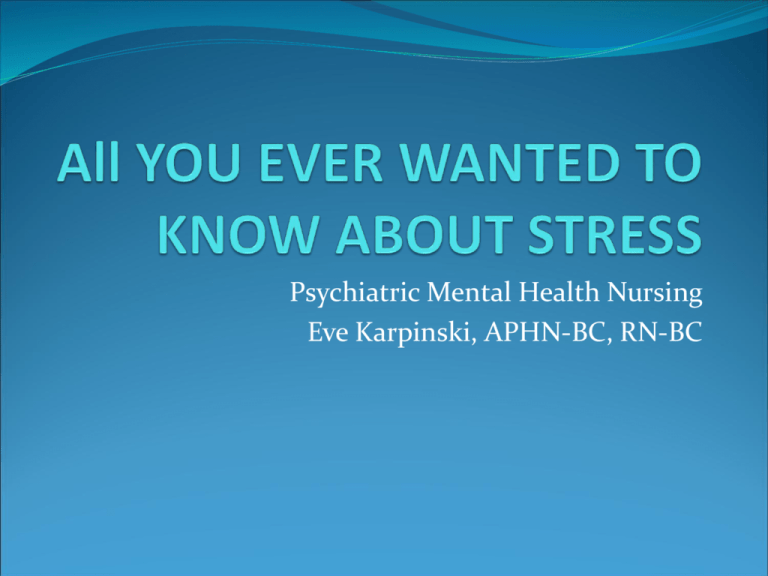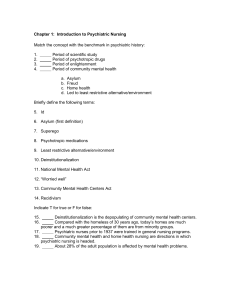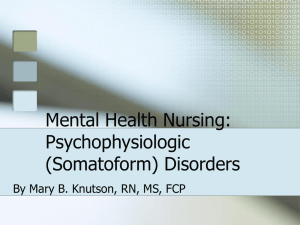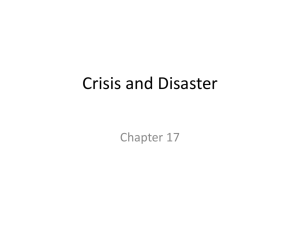All YOU EVER WANTED TO KNOW ABOUT STRESS
advertisement

Psychiatric Mental Health Nursing Eve Karpinski, APHN-BC, RN-BC Question 1 How stress are you now? 1. Not at all. 2. Mildly 3. Moderately 4. Severely Stress The word stress lacks a definitive definition. Adaptation is defined as restoration of homeostasis to the internal environmental system. Adaptation includes responses directed at stabilizing internal biological processes and psychological preservation of self-identity and self-esteem. Stress as a Transaction Between the Individual and the Environment Individual’s perception of the event Primary appraisal – a judgment about the situation in one of the following ways: Irrelevant Benign-positive Stress appraisal Secondary appraisal – an assessment of skills, resources, and knowledge that the person possesses to deal with the situation Precipitating event – a stimulus arising from the internal or external environment and perceived by the individual in a specific manner The physiological of stress . “Fight or Flight” Response When the body encounters a stressor, it prepares itself for “fight or flight.” Identify the adaptation responses that occur in the initial stress response in each of the physical components listed. Physical component Adaptation Response Adrenal medulla Eye Respiratory system Cardiovascular system Gastrointestinal system Liver Urinary system Sweat glands Fat cells Releases norepinephrine and epinephrine. Pupils dilate. Secretion is increased from lacrimal glands. Bronchioles dilate. Respiration rate is increased. Increased force of cardiac contraction Increased cardiac output Increased heart rate Increased blood pressure Decreased gastric and intestinal motility Decreased secretions Sphincters contract Increased glycogenolysis and gluconeogenesis Decreased glycogen synthesis Increased ureter motility Bladder muscle contracts Bladder sphincter relaxes Increased secretion Lipolysis Stress Response Adrenal medulla Eye Respiratory system Cardiovascular system Gastrointestinal system Liver Urinary system Sweat glands Fat cells Releases norepinephrine and epinephrine. Pupils dilate. Secretion is increased from lacrimal glands. Bronchioles dilate. Respiration rate is increased. Increased force of cardiac contraction Increased cardiac output Increased heart rate Increased blood pressure Decreased gastric and intestinal motility Decreased secretions Sphincters contract Increased glycogenolysis and gluconeogenesis Decreased glycogen synthesis Increased ureter motility Bladder muscle contracts Bladder sphincter relaxes Increased secretion Lipolysis When the stress response is sustained for an extended period of time the pituitary gland is stimulated by the hypothalamus to release a number of hormones. Match the ultimate physical effects listed below with the appropriate hormone that triggers the response. __________ 1. Adrenocorticotropic hormone (ACTH) __________ 2. Vasopressin (antidiuretic hormone [ADH]) __________ 3. Growth hormone __________ 4. Thyrotropic hormone (TTH) __________ 5. Gonadotropins a. Results in increased serum glucose and free fatty acids. b. Suppression of sex hormones resulting in decreased libido and impotence. c. Increased gluconeogenesis; immunosuppression; anti-inflammatory response; increased sodium and water retention. d. Increased basal metabolic rate. e. Increased blood pressure (through constriction of blood vessels) and increased fluid retention. Stress Mastery Stress Mastery is the utilization of coping strategies in the response to stressful situations. Adaptive coping strategies protect the individual from harm and restore physical and psychological homeostasis. Coping strategies are considered maladaptive when the conflict being experienced goes unresolved or intensifies. Effects of chronic Stress Increase Gluconeogenisis Decrease Immune Decrease inflammatory response Retention of sodium and water Decrease in libido, frigidity and impotence Increase in blood pressure The Physiological of Relaxation Unhealthy Coping Strategies Healthy Coping Strategies Awareness Your own thoughts Relaxation Laughter Meditation Interpersonal communication with caring other Problem-solving Pets Music Aromatherapy Massage Journaling Personality is defined by the DSM-IV-TR as “enduring patterns of perceiving, relating to, and thinking about the environment and oneself that are exhibited in a wide range of social and personal contexts.” Life-cycle developmentalists believe that people continue to develop and change throughout life, thereby suggesting the possibility for renewal and growth in adults. Theories Freud’s theory of psychosexual development Erikson’s eight development stages Harry Stack Sullivan’s interpersonal theory Mahler’s theory of object relations development Piaget’s cognitive development Kohlberg’s theory of moral development Nursing Peplau’s stages Mental Health Defined as “The successful adaptation to stressors from the internal or external environment, evidenced by thoughts, feelings, and behaviors that are ageappropriate and congruent with local and cultural norms.” Stages are identified by age. However, personality is influenced by temperament (inborn personality characteristics) and the environment. It is possible for behaviors from an unsuccessfully completed stage to be modified and corrected in a later stage. Mental Illness Defined as “Maladaptive responses to stressors from the internal or external environment, evidenced by thoughts, feelings, and behaviors that are incongruent with the local and cultural norms and interfere with the individual’s social, occupational, or physical functioning.” Horwitz describes cultural influences that affect how individuals view mental illness. These include Incomprehensibility – the inability of the general population to understand the motivation behind the behavior. Cultural relativity – the “normality” of behavior is determined by the culture. Psychological Adaptation to Stress Anxiety and grief have been described as two major, primary psychological response patterns to stress. A variety of thoughts, feelings, and behaviors are associated with each of these response patterns. Adaptation is determined by the extent to which the thoughts, feelings, and behaviors interfere with an individual’s functioning. Anxiety A diffuse apprehension that is vague in nature and is associated with feelings of uncertainty and helplessness. Extremely common in our society. Mild anxiety is adaptive and can provide motivation for survival. Peplau’s four levels of anxiety Mild – seldom a problem Moderate – perceptual field diminishes Severe – perceptual field is so diminished that concentration centers on one detail only or on many extraneous details Panic – the most intense state Behavioral Adaptation Responses to Anxiety At the mild level, individuals employ various coping mechanisms to deal with stress. A few of these include eating, drinking, sleeping, physical exercise, smoking, crying, laughing, and talking to persons with whom they feel comfortable. Anxiety at the moderate to severe level that remains unresolved over an extended period of time can contribute to a number of physiological disorders – for example, migraine headaches, IBS, and cardiac arrhythmias. Extended periods of repressed severe anxiety can result in psychoneurotic patterns of behaving – for example, anxiety disorders and somatoform disorders. Grief The subjective state of emotional, physical, and social responses to the loss of a valued entity; the loss may be real or perceived. Elisabeth Kübler-Ross (5 Stages of Grief) Denial Anger Bargaining Depression Acceptance Defense Mechanisms Compensation Denial Displacement Identification Intellectualization Introjection Isolation Projection Rationalization Reaction formation Regression Repression Sublimation Suppression Undoing DSM-IV-TR Multiaxial Evaluation System Axis I – Clinical disorders and other conditions that may be a focus of clinical attention Axis II – Personality disorders and mental retardation Axis III – General medical conditions Axis IV – Psychosocial & environmental problems Axis V – Global assessment of functioning rated on the Global Assessment of Functioning (GAF) Scale, which measures an individual’s psychological, social, and occupational functioning Psychobiology The 101st Congress of the U.S. designated the 1990s as the “Decade of the Brain,” with the challenge for studying the biological basis of behavior. In keeping with the neuroscientific revolution, greater emphasis is placed on the study of the organic basis for psychiatric illness. Implications for Nursing Emphasis in psychiatric nursing is on a smooth transition from a psychosocial approach to a biopsychosocial focus Psychiatric nurses must have a specialized knowledge about Neuroanatomy and neurophysiology Neuronal processes Neuroendocrinology Circadian rhythms Genetic influences Psychoimmunology Psychopharmacology Diagnostic technology Neurotransmitters play an important role in human emotions and behavior and are the target for the mechanism of action in many psychotropic medications. Major categories of neurotransmitters Cholinergics Monoamines Amino acids Neuropeptides Pituitary gland Posterior lobe Vasopressin Oxytocin Anterior lobe Growth hormone Thyroid-stimulating hormone Adrenocorticotropic hormone Prolactin Gonadotropic hormones Melanocyte-stimulating hormone Circadian rhythms Follow a near-24-hour cycle in humans and may influence a variety of regulatory functions, including the sleep-wake cycle, body temperature regulation, patterns of activity such as eating and drinking, and hormone secretion. Some mood disorders have been linked to increased secretion of melatonin during darkness hours. Symptoms that occur in the premenstrual cycle have been linked to disruptions in biological rhythms. Sleep-wake cycle is one of the most common biological rhythms that demonstrates circadian influence. Sleep stages 0 – Alpha 1 – Beta 2 – Theta 3 – Delta 4 – Delta REM - Beta Neurochemical influences on sleep-wake cycle Serotonin and L-tryptophan Norepinephrine and dopamine GABA Acetylcholine Ethical and Legal Issues in Psychiatric/Mental Health Nursing Definitions Ethics - the science that deals with the rightness and wrongness of actions Bioethics - term applied to ethics when they refer to concepts within the scope of medicine, nursing, and allied health Values – ideals or concepts that give meaning to the individual’s life Moral behavior – conduct that results from serious critical thinking about how individuals ought to treat others Values clarification – a process of self-exploration through which individuals identify and rank their own personal values Values – ideals or concepts that give meaning to the individual’s life Moral behavior – conduct that results from serious critical thinking about how individuals ought to treat others Values clarification – a process of self-exploration through which individuals identify and rank their own personal values Ethical Considerations Theoretical Perspectives Utilitarianism – an ethical theory that promotes actions based on the end results that produce the most good (happiness) for the most people Kantianism – suggests that decisions and actions are bound by a sense of duty Christian ethics - do unto others as you would have them do unto you; alternatively, do not do unto others what you would not have them do unto you. Natural law theories – do good and avoid evil. Evil acts are never condoned, even if they are intended to advance the noblest of ends. Ethical egoism – decisions are based on what is best for the individual making the decision. Ethical Dilemmas Ethical dilemmas occur when moral appeals can be made for taking either of two opposing courses of action. Taking no action is considered an action taken. Avoiding Liability Respond to the client Educate the client Comply with the standard of care Supervise care Adhere to the nursing process Document carefully Follow up and evaluate Maintain a good interpersonal relationship with client and family Ethical Principles Autonomy – This principle emphasizes the status of persons as autonomous moral agents whose rights to determine their destinies should always be respected. Beneficence – This refers to one’s duty to benefit or promote the good of others. Nonmaleficence – abstaining from negative acts toward another; includes acting carefully to avoid harm Justice – principle based on the notion of a hypothetical social contract between free, equal, and rational persons. The concept of justice reflects a duty to treat all individuals equally and fairly. Veracity – principle that refers to one’s duty to be truthful always. A Model for Making Ethical Decisions Assessment Problem identification Plan Implementation Evaluation Ethical Issues in Psychiatric/Mental Health Nursing The right to refuse medication The right to the least restrictive treatment alternative Legal Considerations Nurse Practice Act defines the legal parameters of professional and practical nursing. Types of Laws Statutory law Common law Civil Law – protects the private and property rights of individuals and businesses Tort Contracts Criminal law – provides protection from conduct deemed injurious to the public welfare Confidentiality and right to privacy Doctrine of privileged communication Informed consent Restraints and seclusion False imprisonment Commitment issues Voluntary admissions Involuntary commitment Emergency commitment The mentally ill person in need of treatment Involuntary outpatient commitment The gravely disabled client Malpractice and negligence Types of lawsuits that occur in psychiatric nursing Breach of confidentiality Defamation of character Libel Slander Assault and battery False imprisonment Invasion of privacy





